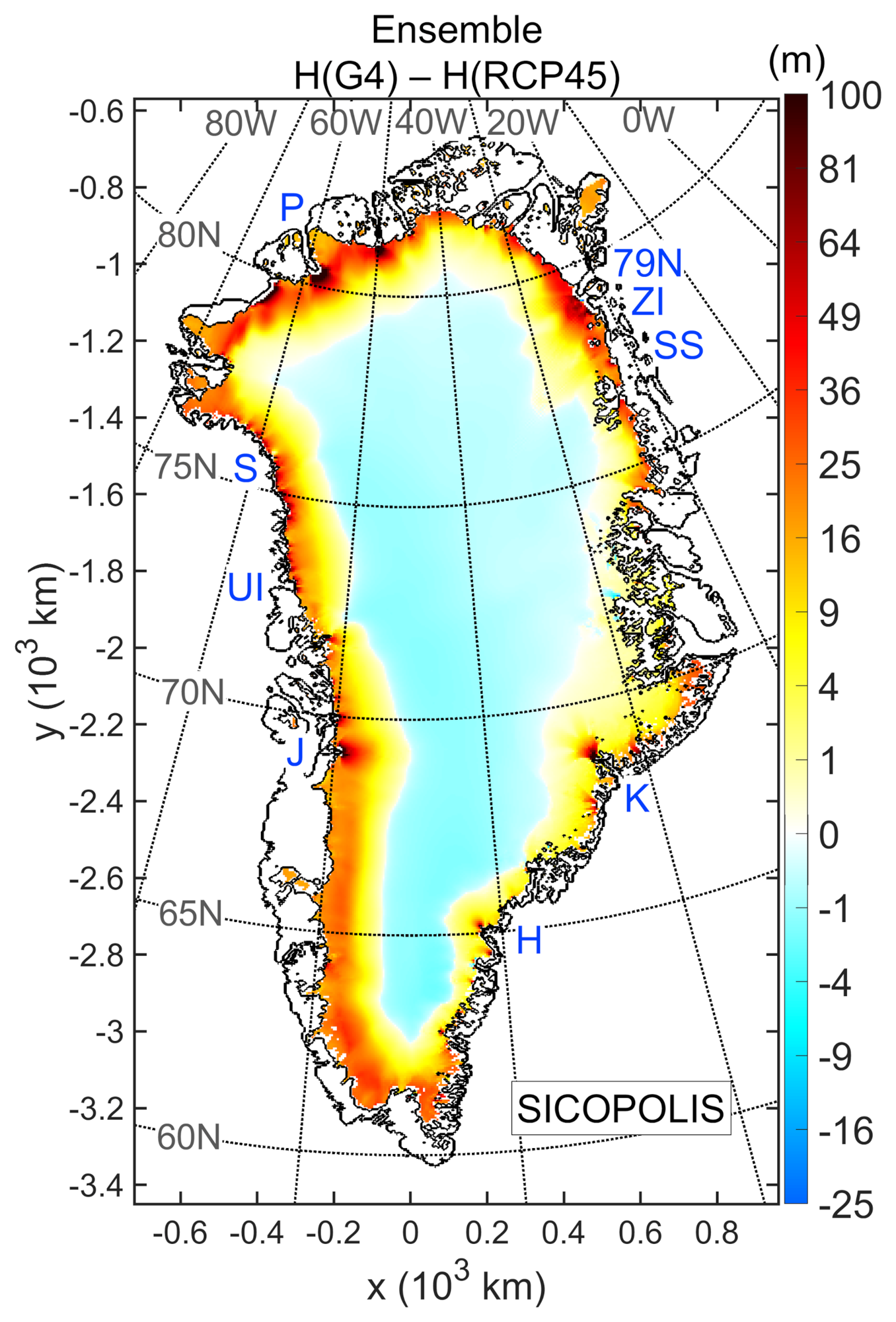Global warming leads to sea-level rise through the melting and retreat of Earth's ice sheets, glaciers, and other sources. As sea levels increase, densely populated coastal areas may become uninhabitable without substantial coastal modifications. To avert this, achieving net-negative carbon emissions is essential, but it proves challenging under present circumstances.
 Results of the SICOPOLIS simulations comparing the change of the Greenland Ice Sheet between GeoMIP G4 and RCP4.5: ice thickness (H). Stratospheric aerosol injection of sulfur dioxide will have the greatest protective effect on the margins (which remain thicker; yellow and red) of the ice sheet. Image Credit: John C. Moore, Ralf Greve et al. Journal of Geophysical Research: Earth Surface.
Results of the SICOPOLIS simulations comparing the change of the Greenland Ice Sheet between GeoMIP G4 and RCP4.5: ice thickness (H). Stratospheric aerosol injection of sulfur dioxide will have the greatest protective effect on the margins (which remain thicker; yellow and red) of the ice sheet. Image Credit: John C. Moore, Ralf Greve et al. Journal of Geophysical Research: Earth Surface.
Numerous proposals aim to significantly mitigate the impacts of climate change, with the most comprehensive ones involving global-scale interventions, known as geoengineering techniques. Although these techniques show promise, the limited understanding of natural cycles hinders a full assessment of their potential benefits.
Under the leadership of Professor John C. Moore from the University of Lapland, Rovaniemi, Finland, and Professor Ralf Greve from the Institute of Low Temperature Sciences, Hokkaido University, an international research team utilized simulations to investigate the possible impacts of the geoengineering method known as the stratospheric aerosol injection on ice sheet melting. The results of their study were published in the Journal of Geophysical Research: Earth Surface.
Stratospheric aerosol injection, or SAI, would artificially introduce aerosols into the stratosphere by aircraft or high-altitude balloons to create a cooling effect via global dimming and increased albedo—the degree to which Earth reflects sunlight.
John C. Moore, Professor, University of Lapland
Utilizing the SICOPOLIS model, Moore, Greve, and their team simulated variations in the Greenland Ice Sheet from 1990 to 2090, considering three distinct scenarios: RCP8.5 (worst-case scenario with unabated warming), RCP4.5 (an intermediate scenario possibly attainable under current conditions), and GeoMIP G4 (a modification of RCP4.5 involving the injection of 5 million metric tons of sulfur dioxide annually into the stratosphere from 2020 to 2070).
The simulations revealed that the SAI of sulfur dioxide effectively shielded the Greenland Ice Sheet. In the RCP8.5 scenario, there was an ice loss equivalent to around 90 mm of sea-level rise; under RCP4.5, the ice loss amounted to approximately 60.6 mm of sea-level rise.
However, under GeoMIP G4, the ice loss was notably restricted to approximately 37.6 mm of sea-level rise. Consistent results were obtained when these scenarios were assessed using a different model, Elmer/Ice. Notably, the margins of the ice sheet exhibited the most significant benefits under GeoMIP G4.
While this study shows that SAI could contribute to the protection of the Greenland Ice Sheet, and hence, potentially, all other ice cover on Earth, geoengineering is a highly contentious topic. The biggest issue is that it addresses only the symptoms of global warming, not the root causes—and may even delay the changes required to address the causes. Furthermore, due to the immense complexity of the natural systems on Earth, it is impossible to predict exactly what positive and negative outcomes could result.
Ralf Greve, Professor, Institute of Low Temperature Sciences, Hokkaido University
National Key Research and Development Program of China (2021YFB3900105); State Key Laboratory of Earth Surface Processes and Resource Ecology (2022-ZD-05); Finnish Academy COLD consortium (322430, 322978); Japan Society for the Promotion of Science (JSPS) KAKENHI (JP16H02224, JP17H06104) funded the study.
The research was also supported by the Arctic Challenge for Sustainability projects (ArCS, ArCS II) of The Ministry of Education, Culture, Sports, Science and Technology of Japan (MEXT; JPMXD1300000000, JPMXD1420318865); and a Hokkaido University Foreign Visiting Professorship at the Institute of Low Temperature Science.
Journal Reference:
Moore, J. C., et al. (2023). Reduced Ice Loss From Greenland Under Stratospheric Aerosol Injection. Journal of Geophysical Research: Earth Surface. doi.org/10.1029/2023jf007112.